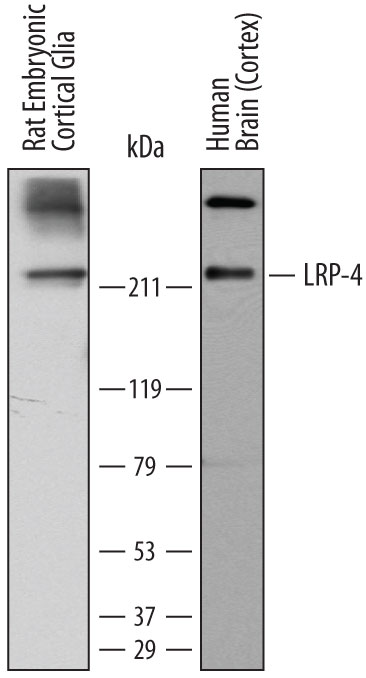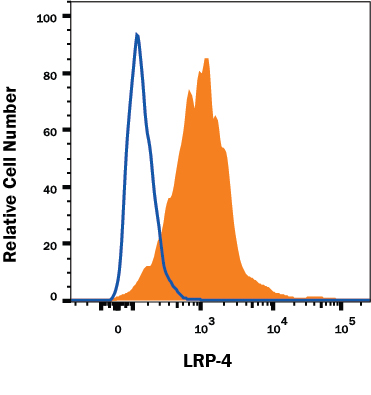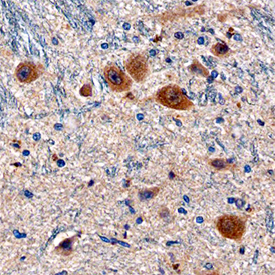Human LRP-4 Antibody Summary
Applications
Please Note: Optimal dilutions should be determined by each laboratory for each application. General Protocols are available in the Technical Information section on our website.
Scientific Data
 View Larger
View Larger
Detection of Human and Rat LRP‑4 by Western Blot. Western blot shows lysates of rat embryonic cortical glial cells and human brain (cortex) tissue. PVDF membrane was probed with 2 µg/mL of Mouse Anti-Human LRP-4 Monoclonal Antibody (Catalog # MAB5948) followed by HRP-conjugated Anti-Mouse IgG Secondary Antibody (Catalog # HAF007). A specific band was detected for LRP-4 at approximately 220 kDa (as indicated). This experiment was conducted under reducing conditions and using Immunoblot Buffer Group 1.
 View Larger
View Larger
Detection of LRP‑4 in U-2 OS Human Cell Line by Flow Cytometry. U-2 OS human osteosarcoma cell line was stained with Mouse Anti-Human LRP-4 Monoclonal Antibody (Catalog # MAB5948, filled histo-gram) or isotype control antibody (Catalog # MAB002, open histogram), followed by Phycoerythrin-conjugated Anti-Mouse IgG Secondary Antibody (Catalog # F0102B). View our protocol for Staining Membrane-associated Proteins.
 View Larger
View Larger
LRP‑4 in Human Brain. LRP-4 was detected in immersion fixed paraffin-embedded sections of human brain (medulla) using Mouse Anti-Human LRP-4 Monoclonal Antibody (Catalog # MAB5948) at 15 µg/mL overnight at 4 °C. Before incubation with the primary antibody, tissue was subjected to heat-induced epitope retrieval using Antigen Retrieval Reagent-Basic (Catalog # CTS013). Tissue was stained using the Anti-Mouse HRP-DAB Cell & Tissue Staining Kit (brown; Catalog # CTS002) and counter-stained with hematoxylin (blue). Specific staining was localized to cytoplasm of neurons. View our protocol for Chromogenic IHC Staining of Paraffin-embedded Tissue Sections.
Reconstitution Calculator
Preparation and Storage
- 12 months from date of receipt, -20 to -70 degreesC as supplied. 1 month, 2 to 8 degreesC under sterile conditions after reconstitution. 6 months, -20 to -70 degreesC under sterile conditions after reconstitution.
Background: LRP-4
LRP-4 (Low density lipoprotein-related protein #4; also MEGF7 and LRP13) is a 220-270 kDa glycoprotein, member of the LDLR family of proteins. It is expressed on neurons, oocytes, spermatogonia and skeletal muscle cells and binds multiple ligands including WISE, apoE, MuSK and neuronal Agrin. It serves to negatively regulate Wnt signaling during development and to cluster AChRs at neuromuscular junctions. Mature human LRP-4 is an 1885 amino acid (aa) type I transmembrane glycoprotein. It contains a 1705 aa extracellular domain (ECD) (aa 21-1725) plus a 159 aa cytoplasmic region (aa 1747-1905). In the ECD, there are eight LDLR class A repeats (aa 26-350), two EGF-like repeats (aa 354-434) and 20 LDLR class B repeats that contain an intervening EGF-like domain (aa 480-1610). Over aa 18-344, human LRP-4 shares 97% aa identity with both mouse and rat LRP-4. MAB5948 detects the correct rat band in Western Blot. Immunohistochemistry was not tested in rat samples.
Product Datasheets
FAQs
No product specific FAQs exist for this product, however you may
View all Antibody FAQsReviews for Human LRP-4 Antibody
There are currently no reviews for this product. Be the first to review Human LRP-4 Antibody and earn rewards!
Have you used Human LRP-4 Antibody?
Submit a review and receive an Amazon gift card.
$25/€18/£15/$25CAN/¥75 Yuan/¥2500 Yen for a review with an image
$10/€7/£6/$10 CAD/¥70 Yuan/¥1110 Yen for a review without an image

